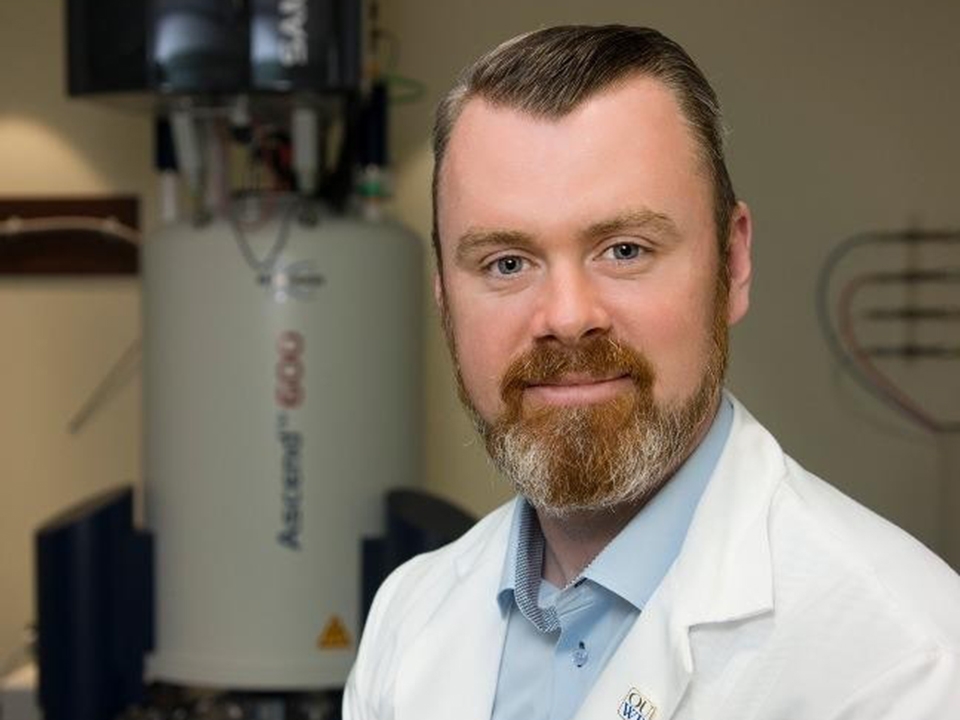Advancing Equity Through Early Prevention of Alzheimer's Disease
October 9, 2025
Stewart Graham, PhD, began his Alzheimer’s disease research journey thousands of miles from Michigan, in a rural town in Northern Ireland.
Growing up during “The Troubles” — a time of political unrest in Northern Ireland — he was no stranger to adversity. But it was a deeply personal loss that shaped his life’s mission: the passing of his grandmother during his teenage years.
“I spent much of my early life with my grandmother,” he recalled. “She passed due to complications from Alzheimer’s disease.”
After earning degrees in biochemistry, proteomics, and a metabolomics PhD from Queen’s University in Belfast, Dr. Graham trained in food biosafety, deliberately seeking out the most advanced analytical techniques with the aim of making food safer and lives healthier.
His research success led him to international conferences, where a chance meeting with Ray Bahado-Singh, MD, changed his career trajectory. Dr. Bahado-Singh approached Dr. Graham after viewing his Alzheimer’s research posters and said, “This is fabulous. Fantastic. I’ve got a job for you.”

When Dr. Graham arrived to Royal Oak in 2014 to lead metabolomics research, he stepped into an empty lab, ready to build the most ambitious Alzheimer's inequity research in the country. Today, that lab is a bustling hub, anchoring some of the most ambitious Alzheimer’s inequity research in the country.
Building a landmark study from the ground up
One of Dr. Graham’s leading initiatives is the Black American United Memory & Aging Project, designed to investigate why Black Americans, particularly Black women, face significantly higher rates of Alzheimer’s disease.
The statistics are sobering: Black Americans are two to three times more likely to develop Alzheimer’s than white counterparts; Black women may be up to six times more likely than white men.
To uncover the causes, Dr. Graham’s team measures biological factors like telomere length (protective DNA caps that fray faster under stress) and inflammatory biomarkers such as cytokines. These biological indicators are paired with lived-experience data, including exposure to racism, economic stability, and community context. Recruitment strategies for research participants rely on trusted entry points, such as partnering with churches and training local “ambassadors” to engage community members.
Partnership is a hallmark of his work. The Black American United Memory & Aging Project is a collaboration with Clemson University, Johns Hopkins University, and North Carolina Agricultural and Technical State University — a historically Black university — whose involvement is vital to building trust and ensuring cultural competence. Corewell Health serves as the data hub, coordinating information from all sites.
The study’s long-term ambition goes beyond one community.
“We want to get into the Hispanic communities, the Polish communities, the Chinese communities and so forth,” Dr. Graham said. “Because different populations are at greater risk of developing Alzheimer’s disease, by not incorporating all communities, we risk developing interventions that only work for white patients, which is the case for most current Alzheimer’s drug trials where 95% of participants are white.”
The long road from bench science to bedside
It took three years to get the infrastructure in place for the Black American United Memory & Aging Project, a reminder that impactful research is a marathon, not a sprint.
“From the time it was a germ of an idea to when it actually got going, it was really different by that time,” Dr. Graham said, noting it takes about 15 years on average for research to progress from the lab to interventions that change patient care.
Basic science, he insists, is where every cure begins.
“Every cure, every treatment, every medicine that is available today started in a lab,” he said. Without it, “you’re stunting growth, you’re stunting the ability for individuals like myself to get it to that translational stage, to get it to the clinic.”
This foundational work also shapes his focus on early intervention. Dr. Graham’s findings show that Alzheimer’s-related plaque buildup and telomere shortening, both linked to cognitive decline, often begin in a person’s 40s, decades before symptoms emerge.
“By the time the clinical symptoms become apparent, it’s too late. Those tangles and plaques are already created within the brain,” he said.
Translating science into change
Dr. Graham envisions a future where Alzheimer’s prevention strategies are personalized to each community’s risk profile. “It’s a personalized medical approach. If we understand why, then we can ask, ‘Well, how do we address that?’”
Achieving that vision means interventions at multiple levels:
- Clinical – Identifying at-risk individuals earlier, using blood-based biomarkers for routine screening
- Organizational – Embedding research insights into health system practices
- Community – Partnering with trusted local institutions to deliver education and resources
Dr. Graham’s philosophy applies to all of Corewell Health.
“We are doing impactful research. We’re doing things that we hope are going to change people’s lives in the future,” he said. “There’s a lot of really, really good research being done that I think a lot of people don’t know about.”
Despite national funding cuts, Dr. Graham’s team recently received a five-year, $5.7 million National Institutes of Health grant. He credits the success to a collaborative network that has grown from five people to around 30, all committed to the mission.
Looking ahead
The Black American United Memory & Aging Project model will form the backbone of a planned 20-year longitudinal study tracking multiple populations. The goal: pinpoint modifiable risk factors and tailor prevention efforts long before memory loss begins.
Dr. Graham’s vision also includes a new translational neuroscience department to integrate Alzheimer’s research with work on Parkinson’s disease, stroke, traumatic brain injury, and other brain disorders.
“This all takes a village,” Dr. Graham said. “We’re just bringing in the right people to do it.”
Corewell Health isn’t just collecting data, we are building the foundation for how we’ll fight Alzheimer’s in the future — inclusively, equitably and effectively.

